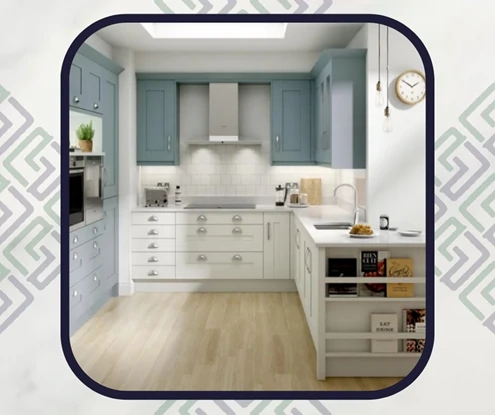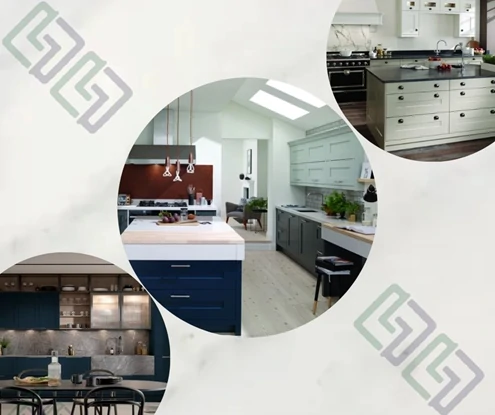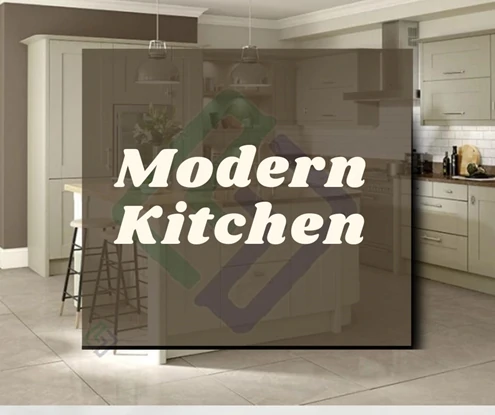The Evolution of Kitchens (History and Development):
The kitchen is considered a vital center in any home, where food is prepared, family conversations are exchanged, and innovative cooking experiences take place. Throughout history, kitchens have witnessed significant transformations that align with the evolution of culture, technology, changes in family needs, and lifestyles. Let’s take a look at this exciting history and its developments.
The ancient kitchen: In ancient times, kitchens were limited to a small space containing an open fire and some basic utensils. The cooking process required a lot of time and effort, and food was prepared manually using simple tools.
The transition towards the modern kitchen: With the advancement of technology and the expansion of human knowledge, kitchens have witnessed tremendous developments. Electric ovens and gas stoves emerged, facilitating the cooking process and making it faster and safer. The quality and durability of kitchen tools and utensils have also improved.
The modern kitchen: In the current era, the kitchen is characterized by continuous evolution and advanced technology. Smart cooking appliances such as smart ovens and advanced cooking utensils allow remote control via smartphones. There is also an increased focus on kitchen design to meet the needs of modern families, providing functional and aesthetic spaces that suit contemporary lifestyles.
Future trends: It is expected that the evolution of kitchens will continue, with advancements in technology such as 3D printing and artificial intelligence. New techniques may emerge to make the cooking process easier and more precise, in addition to further integration between devices and control through voice and motion commands.
As the heart of the home, the kitchen reflects the advancements of society and technology throughout the ages. Thanks to modern technologies and innovative design, the cooking experience and sharing moments in the kitchen have become unforgettable experiences.

The Old Kitchen (History and Traditions):
The old kitchen is one of the prominent aspects that shape the culture
of ancient civilizations. It is not just a place for preparing food but also
reflects the traditions and customs of societies and how they interacted with
their environment and natural resources. Let’s delve into the world of ancient kitchens and
discover their unique aspects.
1-Design
and structure: In ancient times, kitchens were usually limited to
small spaces inside homes or places used for cooking. They primarily consisted
of open hearths used to ignite fires and heat food. Utensils and tools were
often made from locally available materials such as clay and stone.
2-The role of the kitchen in
daily life:
In ancient times, the kitchen was
more than just a place for preparing food; it served as a center for social
interaction and family bonding. Women were usually responsible for managing the
kitchen and preparing meals, and these activities provided opportunities for
exchanging stories and knowledge among family members.
3-Traditional foods and
recipes:
The types of traditional foods and
recipes varied based on culture and region, heavily relying on locally
available resources. Fresh and seasonal foods formed the basis of nutrition,
with the use of herbs and spices to enhance the flavor and nutritional value of
the food.
4-Rituals
and traditions: In ancient times, the kitchen played an important
role in social and religious rituals and traditions. There were customs such as
serving food to guests as an expression of hospitality and respect, and
organizing feasts and religious celebrations that included preparing special
and delicious dishes.
Top of Form
The ancient kitchen demonstrates the importance of food and cooking in human life throughout the ages, showing that it is not merely a biological process but also reflects the values and traditions of societies. Thanks to the development of civilization and technology, the aspects of the kitchen have changed, but they still retain the spirit and traditions of the past, enriching the experience of cooking and social interaction in modern times.

Modern Kitchen (History and
Traditions):
Kitchens have evolved significantly throughout history, and this
evolution has been reflected in many aspects such as design, technology used,
and dietary habits.
Here’s a look at the history and traditions of the modern kitchen:
1-History
of Technology in the Modern Kitchen: Technology began to enter
kitchens in the twentieth century, with the emergence of household appliances
such as refrigerators, electric ovens, and automatic dishwashers. These
technologies have contributed to improving the efficiency of the kitchen and saving
time and effort.
2-Changes in Design and Décor: Kitchens have undergone significant
changes in design and décor over time. From classic kitchens to modern kitchens
with sleek and elegant designs, new materials and innovative construction and design
methods have been used.
3-Changes in Dietary Habits: Cooking and dietary habits have been influenced by
technological advancements and social changes. The popularity of fast cooking
and ready-made meals has increased due to the fast-paced modern lifestyle and
people’s busy schedules. However, at the same time, there has been a growing
interest in healthy nutrition and the use of natural ingredients.
4-Transformations
in Kitchen Functions: The kitchen has undergone significant shifts
in its functions, expanding beyond mere food preparation. Kitchens are now
sometimes used as workspaces, study areas, or even social gathering spaces,
highlighting their role as the focal point of family life.
5-Continuity
of Traditions: Despite all the advancements, some old traditions and traditional
cooking methods continue to be practiced in modern kitchens. People are keen on
preserving these traditions and passing them down from generation to
generation, giving the kitchen a touch of heritage and authenticity despite
modern developments.
In short, the modern kitchen is a product of technological and social
advancements, serving as a vibrant space that blends old traditions with modern
technology in food preparation and provides a space for social and family interaction.

Modernistic Kitchen (History and Traditions):
Modernistic kitchens are
characterized by their sleek and functional designs, a product of technological
and social advancements throughout the ages. Here’s an overview of the history and traditions of
modern kitchens:
1-History
of Technology in the Modern Kitchen: The real impact of
technology on the kitchen began during the twentieth century when household
appliances such as refrigerators, electric ovens, and cooking machines evolved.
These technologies contributed to improving the efficiency of the kitchen and made
the cooking process easier and more convenient.
2-Evolution of Design and
Décor:
Modern kitchens have undergone
significant transformations in design and décor. New materials such as
stainless steel and tempered glass have been used, and designs have become more
modern and minimalist, with a focus on cleanliness and organization.
3-Changes in Dietary Habits: Cooking and dietary habits have been influenced by
technological advancements and social changes. The popularity of fast cooking
and ready-made meals has increased due to the fast-paced modern lifestyle and
people’s busy schedules. However, at the same time, there has been a growing
interest in healthy nutrition and the use of natural and organic ingredients.
4-Transformations in Kitchen
Functions:
Modern kitchens have become
multifunctional spaces, sometimes used for working from home, studying, or
social gatherings. Additionally, modern kitchens are designed to allow easy
movement and provide ample storage space.
5-Continuity of Traditions: Despite all the advancements, some old traditions and
traditional cooking methods continue to be practiced in modern kitchens. People
are keen on preserving these traditions and passing them down from generation
to generation, giving the kitchen a touch of heritage and authenticity despite
modern developments.
In summary, the modern kitchen is a product of technological and social
advancements, serving as a vibrant space that blends old traditions with modern
technology in food preparation and provides a space for social and family
interaction.
Conclusion:
Top of Form
Top of Form
Top of Form
In conclusion looking towards the future,
kitchens are likely to continue evolving and changing to meet the needs of
changing societies. However, it is important to maintain the spirit of
tradition and culture in kitchen designs, to remain a center for social and
family interaction across generations.
In closing the discussion on the history of kitchens, it is clear that they embody a sophisticated culture and continuous technological evolution throughout the ages. From ancient times to the modern era, kitchens have been a hub for family and social life, where meal preparation and participation in cooking are integral parts of the family and community experience.

